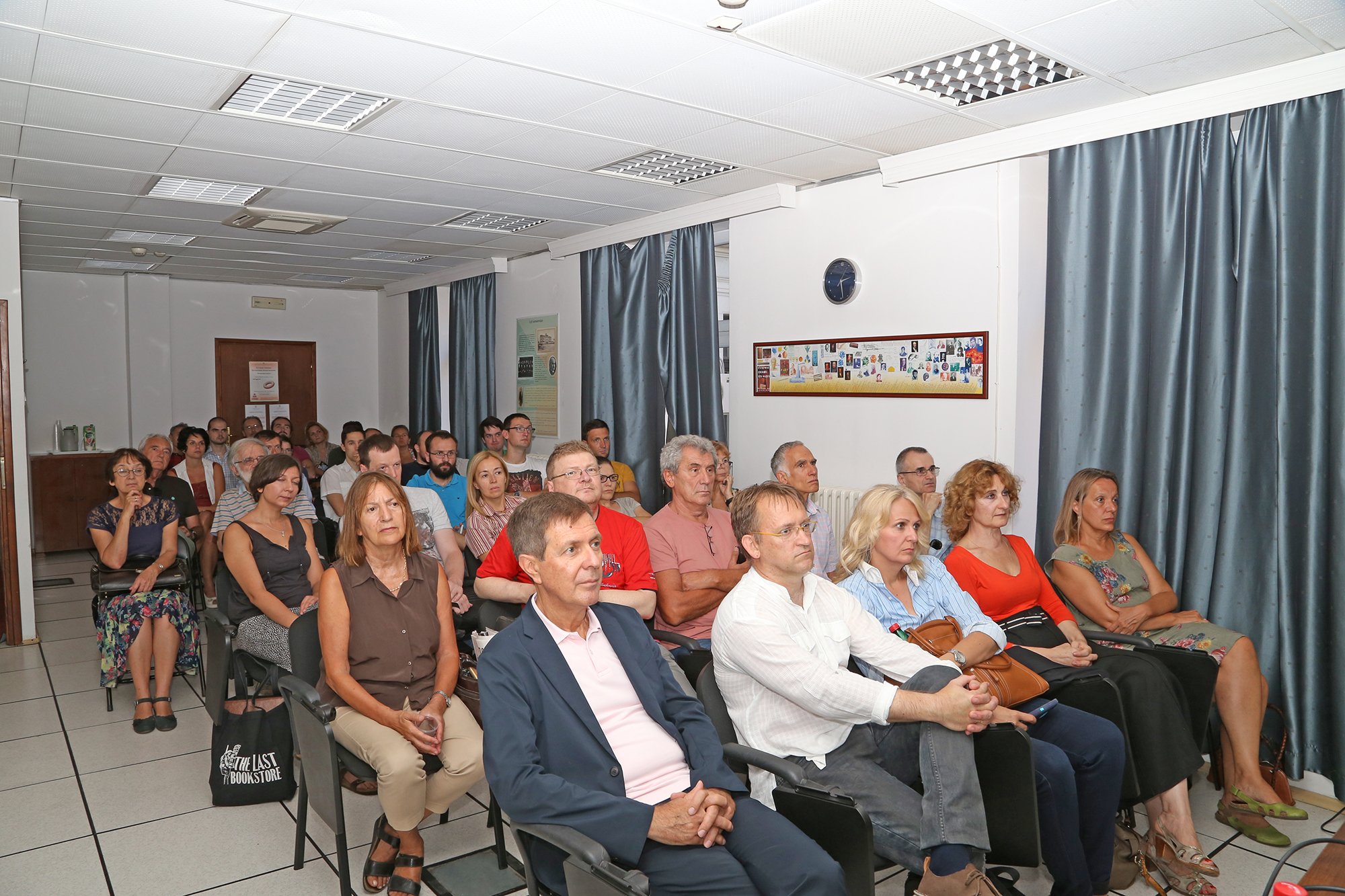The Faculty of Mathematics of the University of Belgrade (MATF) and the Mathematical Institute (MI SANU) are certainly the central Serbian institutions in which mathematical sciences are studied and developed: theoretical and applied mathematics, computer science, mechanics, astronomy and astrophysics. We recognise the importance of these institutions due to the fact that until the 1950s, mathematics was not taught at the tertiary level in other cities in Serbia. Professors of mathematics at the University of Belgrade and members of the Mathematical Institute initiated the creation of mathematical departments outside Belgrade. For example, the founder of the Mathematical School at the University of Novi Sad was Professor and Academician Bogoljub Stanković, who earned his doctorate as an assistant at the Mathematical Institute. The creation of the first mathematical institution in Serbia was initially related only to tertiary level mathematics teaching, which began after the founding of the Lyceum in 1838. The predecessor of the Faculty of Mathematics is the Department of Mathematics at the Faculty of Philosophy, which was founded in 1873. Therefore, this year is considered informally as the year when the Faculty was established. Although the Department really had a complete autonomy in teaching and developing mathematics since then, the Faculty under its current name would be established only 120 years later by separating from the Faculty of Sciences and Mathematics, formerly a department of the Faculty of Philosophy, and becoming separate faculties of natural sciences.
From the end of the 19th century until the outbreak of World War I, theoretical and applied mathematics were taught at the University of Belgrade by Mihailo Petrović Alas, Bogdan Gavrilović and Milutin Milanković. His works on differential equations and polynomial geometry, gained Petrović a world reputation, and before the beginning of World War I, his students Mladen Berić and Sima Marković defended their first doctorates in mathematics in Serbia. Soon after Belgrade Mathematical School was established, namely in the 1920s, there appeared a necessity for some, at least informal, institution where Belgrade mathematicians would assess their results and exchange their mathematical experiences through presentations. Therefore, at the end of the 1920s, the Mathematicians' Club was formed, which is considered the forerunner of the Mathematical Institute.
The name "Mathematical Institute" was first mentioned in a memorandum of a letter signed by Mihailo Petrović Alas and Anton Bilimović in 1932. The letter sent to the Academy contained the request for launching and financing of the Publications de l'Institut Mathématique (PIM), which was founded in 1932. The Mathematical Institute was established in 1946 as the first Academy Institute. In that process, the central place was naturally given to academics and professors of mathematics, mechanics and astronomy of the Faculty of Philosophy: Anton Bilimović, the first director of the Institute, Jovan Karamata, Milutin Milanković, Nikola Saltikov and Vojislav Mišković. Radivoj Kašanin and Ivan Arnovljević, professors of the Technical Faculty, were the first members of the Scientific Council. In addition, all lecturers of the Department of Mathematics at the Faculty of Philosophy were also members of the Mathematical Institute.
Since the foundation of the Mathematical Institute until today, the largest number of members of the Institute have been researchers who completed their basic, master's (or magister's) or doctoral studies at the Faculty of Mathematics. As a rule, professors at the Faculty of Mathematics were in the governing bodies of the Institute, such as the Scientific Assembly of the Institute. Several professors of the Faculty of Mathematics were at the same time directors of the Institute. Besides Bilimović, we would mention Jovan Karamata, Veljko Vujičić and Đuro Kurepa. Scientific work at the Institute was organised through the Department of Mathematics and the Department of Mechanics. Very often, the heads of these departments were professors from the Faculty of Mathematics.
The spatial proximity of the Faculty of Mathematics (located at 16 Studentski Trg) and the Mathematical Institute (located at 35/36 Knez Mihailova Street) has also contributed to the launch and successful implementation of numerous joint scientific research and professional activities such as the publishing of journals, and organising seminars, scientific projects, conferences and teaching. The following is an overview of some of the joint activities of these two institutions.
Publications de l'Institut Mathématique is the oldest and, for a long time, the leading Serbian journal in mathematics. From the beginnings of PIM until today, professors of the Faculty of Mathematics have always been represented in the editorial board of the journal, and very often, the editor-in-chief was from the Faculty of Mathematics (Mihailo Petrović, Milutin Milanković, Đuro Kurepa, Jovan Karamata, and many others). In this journal, a large number of lecturers and researchers from the Faculty of Mathematics from various fields of mathematics and its applications have published their results. Among the jointly created journals, we would mention Computer Science and Information Systems launched in 2004 (the consortium of publishers includes MI SANU and MATF), which is currently in the M23 category in the field of computing. There are also numerous non-periodic editions: monographs, conference proceedings and special editions that represent joint publications of the Faculty of Mathematics and the Institute of Mathematics.
A number of scientific conferences held were jointly organised by these two institutions, starting with the Congress of Mathematicians of Serbia (Yugoslavia), the National Conference of Astronomers of Serbia, through international conferences (Geometrical Seminar, Belgrade Bioinformatics conference – BelBi, Mathematical Physics Meeting), as well as other scientific conferences, and professional gatherings (Symposium on Operational Research SYM-OP-IS, Conference on Digitisation of Scientific and Cultural Heritage, gatherings dedicated to teaching of mathematics, prominent mathematicians, etc.)
Probably the most important type of cooperation is the large number of seminars jointly established by researchers at these two institutions, which are realised at the Mathematical Institute or the Faculty of Mathematics. According to the strucuture of participants and leaders, these scientific meetings can be considered as joint seminars of MI SANU and MATF. Some of them are: Seminar on Combinatorics, Geometry, Topology and Algebra – CGTA (long-term leaders are Professor Siniša Vrećica from MATF and Professor Rade Živaljević from MI SANU); Seminar on Geometry and Applications (among current and previous leaders are Professor Zoran Rakić, Professor Mirjana Đorić, Professor Srđan Vukmirović, Professor Miroslava Antić from MATF); Computer Science and Applied Mathematics Seminar (among the leaders for many years is Professor Milan Dražić from MATF); Seminar on the History and Philosophy of Mathematics, Mechanics and Astronomy (supervised by Professor Milan Božić from MATF); The Theory of Relativity and Cosmological Models Seminar (supervised by Professor Žarko Mijailović from MATF), etc. The seminars are open and available to mathematicians from other faculties of the University of Belgrade, from other universities in Serbia, as well as from abroad, and they all participate in their work.
The cooperation between MI SANU and MATF is also reflected in national or international scientific projects with teams made up of researchers from both institutions, and the project holders are either the Faculty of Mathematics or the Mathematical Institute. This form of cooperation has been particularly intensified since the Ministry of Education, Science, and Technological Development (formerly the Ministry of Science, i.e. the Ministry of Education) has been financially supporting projects in the field of basic research, technological development and interdisciplinary research projects since the 1970s. Some of the realised joint projects are: Geometry, Education and Visualisation With Applications (2002-2005, 2006-2010, 2011-2019); Mathematical Models and Optimization Methods for Large-Scale Systems (2002-2005, 2006-2010, 2011-2019); Topology, Geometry and Global Analysis on Manifolds and Discrete Structures (2011-2019); Approximation of Integral and Differential Operators and Applications (2011-2019); Graph Theory and Mathematical Programming with Applications in Chemistry and Computing (2011-2019); Development of New Information and Communication Technologies, Using Advanced Mathematical Methods, with Applications (2011-2019); Cultural Heritage Digitisation (2011-2019), Representations of Logical Structures and Their Application in Computer Science (2006-2010); History and Philosophy of Mathematics and Natural Sciences (2006- 2010); The Application of Information Technologies in Digitisation of Scientific and Cultural Heritage (2008-2011); Methods of Mathematical Logic for Decision Support in Real Life Situations (2002-2005); History and Philosophy of Mathematics (2002-2005); Mathematical Methods and Algorithms for Recognition of 3D Contours (2002-2005) and others.
During the previous decades, members of the Mathematical Institute participated in delivering lectures and the whole teaching process at the Faculty of Mathematics or support teaching activities in numerous ways. Several researchers of MI SANU were hired, i.e. appointed to teaching positions, at the Faculty of Mathematics: Zoran Marković, Zoran Ognjanović, Zoran Petrić, Predrag Tanović, and others. On the other hand, a number of teachers or assistants at the Faculty of Mathematics transferred to the Mathematical Institute and continued to work there. The creation of the Computer Laboratory at the MATF is related to the transfer of a group of researchers in the field of computing from MI SANU to the MATF as well as the transfer of the large computer IBM 360 to the Faculty of Mathematics.
The Mathematical Institute and the Faculty of Mathematics are close, but still independent institutions. Each of them invest the greatest efforts to perform the activity for which it was established in the best possible way. The Faculty of Mathematics, as a teaching-scientific institution, is primarily focused on education and improvement of teaching mathematics, computer science, mechanics and astronomy in undergraduate and postgraduate studies, but it is also the bearer of various types of scientific and research activities. The Mathematical Institute is a scientific institution, so the associates from the Institute are primarily engaged in science by performing project tasks and tasks related to the organisation of science. In the brief account, provided here, of the cooperation of these two Institutions, we can see that these two activities (scientific and teaching) are intertwined and difficult to separate. University professors are as engaged in science as they are in their lectures, while the associates of the institute always have the desire to transfer their knowledge to younger colleagues and students. As our renowned professors, who created these institutions have already noticed, there is no real science without a good education, nor a good education without the real science.
Gallery

The meeting of Seminar for Computer Science and Applied Mathematics, Prof Zoran Obradović's lecture, September 5, 2017.
Archive of the Mathematical Institute SANU


